Since becoming a professional photographer, my career has had twists and turns, but one common thread has always been the presence of snow and mountains. For many years, I made a living as a professional ski photographer, shooting the world’s best skiers in winter locations worldwide. These days, I live in the Yukon, just south of the Arctic Circle, where winter temperatures can dip to -40C (-40F), and weeks can pass during the darkest months without seeing the needle climb above -17C (0F).
In other words, my situation and experience put me in a unique position to compare the functionality of the top photography gloves on the market. So that’s what I did, and continue to do as new gloves come to the market. Every glove in this guide has been tested in temperatures that ranged from mild to downright deadly.


Table of Contents
In A Hurry?
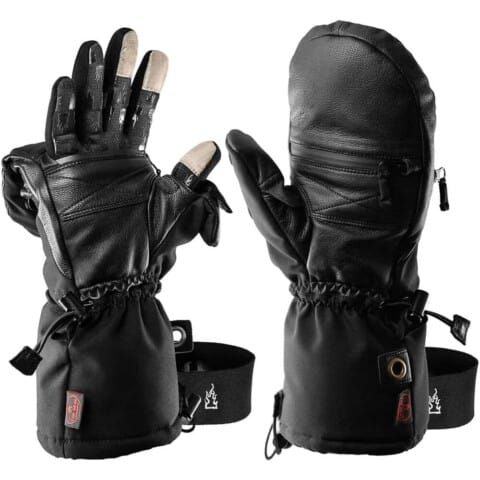

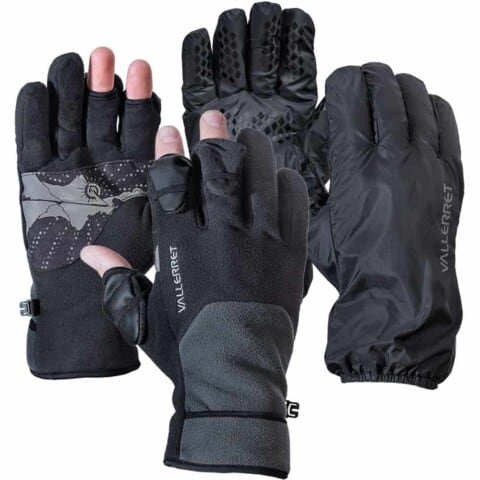
If you’re in a hurry and need a quick answer without reading the entire guide, you can’t go wrong with the Heat 3 Smart Pro from The Heat Company for a severe winter glove, the Heat 2 Softshell Mitt for moderately cold conditions, or the Vallerret Milford glove for mild winter conditions.
A Note On Glove Temperature Ratings
The temperature at which a glove is comfortable is a very personal, subjective thing. For this reason, glove manufacturers never list recommended temperatures alongside their gloves. Still, throughout this guide, I occasionally mention my comfort levels with different gloves. It’s important to understand that you should only use these temperatures as a relative guide and not as a definitive temperature for your comfort in those gloves.
I have spent most of my life living in cold climates, and I regularly walk around gloveless in temperatures that confuse visiting friends and family. In short, I have developed a tolerance to the cold that most readers will probably not have. If I say that one glove is comfortable for me at -40C and another at -20C, you should use this information only to understand that glove A is warmer than glove B. Not that you will be comfortable in that glove at those temperatures.
The Best Photography Gloves You Can Buy
To put together the contenders, I checked in with partner stores to find their best-selling and best-reviewed products. Then, I took to my social media channels and our vast email newsletter list to find out which photography gloves my readers already use. This always turns up some new options not previously on my radar. Regarding photography gloves, I’ve tried to find options that suit a broad range of temperatures. There need to be great gloves for temperatures around 0C (32F), just as much as there need to be great gloves for temperatures below -40C (-40F).
Generally speaking, when I do group tests like this, a few products don’t cut it, and I stop using them quickly. I don’t see the point of cluttering the guide with gloves with no redeeming features above other options, so I’ll leave those out entirely. The gloves I’m left with–the ones in this guide–are all good products. There are some I like better than others, as you’ll see, but if they made it this far, then they’re a solid product that’ll be just right for some people.
The Heat Company Heat 2 Softshell




The Heat 2 Softshell glove is a flippable mitt with a fingerless glove design hiding underneath it. The palms are soft, durable, and highly water-repellant goat leather, while the rest of the glove is stuffed with wind-resistant Thinsulate. When I set out to test all these gloves for the guide, I had pre-conceived expectations based on price points and specifications. More than any other glove on this list, the Heat 2 Softshell wildly exceeded these expectations, and it did it at a price (under $80) that makes them very affordable.
While testing the Heat 2 Softshell mitts, I loved how easy it was to pull back the mitt and expose all my fingers, and then I appreciated how fast and easy it was to cover them up again. Photography gloves that use zippers to reveal your fingers can’t compete with the speed of the Heat 2 Softshell.
The design of this glove also gives it the broadest usable temperature range of any glove in this guide. On warmer days or during high aerobic activity, the glove is perfectly useable without using the mitt portion. When the mitt is flipped back and secured with the hook and loop pad, it feels like you are wearing a fingerless glove. In contrast, most other larger flippable mitts feel like you are temporarily wearing a mitt that has been folded back. It’s a subtle but essential difference.
When you flip the Thinsulate-lined mitt over your fingers, the material is highly wind-resistant and increases the warmth enormously. On top of that, the mitt section also features a pocket to hold a hand warmer. Even without using that option, I was comfortable wearing this glove in temperatures as low as -18°C (0°F) in the dry cold we experience in the Canadian North. If you want to use it in even colder temperatures, pair it with The Heat Company’s thinnest liner, the Merino Light Liner.
All this makes the Heat 2 Softshell the most versatile photography glove in this guide, with one caveat: Don’t put your hand in the snow! If you’re doing any activity in the snow that might involve you accidentally, or necessarily, putting your hands into deep snow, then this is not the right glove for the purpose. This mitt doesn’t seal your fingers away; it’ll just scoop up the snow. This prevented me from using this glove for ski and snowboard photography, but I found it perfect for landscape and wildlife work in modestly cold (by my standards) conditions.
RucPac Extreme Tech Gloves



The RucPac Extremes are thickly insulated full mitt flipper-style photography gloves that are incredibly comfortable on a cold, dry day. Much like the similarly designed Heat 2 Softshell glove from The Heat Company, I was happy using these down to -18c (0F), but it must be remembered that this style of flipper glove is no good in wet weather or heavy snowfall. Compared to the similar Heat 2 Softshell mitts, the RucPac Extreme’s face fabric is not as durable, and I would not expect these gloves to last as long. They are also much bulkier and less wind-resistant. Still, they are around $20 cheaper, so that will be a balance that some might want to consider. For more details, check out my RucPac Extreme Tech Glove review.
Vallerret Milford Glove



The Vallerret Milford gloves are a unique entry into the photography glove market. Currently selling for $69, these fleece gloves are on the cheaper end of the spectrum, but they have a trick up their sleeve that helps to differentiate them from some of the other more affordable options. Tucked into a small pocket on the wrist of each glove is a rip-stop nylon shell with 10K waterproofing. Fleece gloves are cost-effective and cozy, but their obvious downside is usually a lack of resistance to any precipitation. With the Milford Glove, Vallerret has uniquely solved this problem if you get caught in a downpour.
Two flippable fingers and a thumb improve access to your camera controls. To keep the weight and price of the gloves down, these fingertips are secured by small elastic loops instead of the oft-seen magnets when they are flipped backward. I don’t have an issue with this at all. This method is secure, which cannot always be said for the magnets I have seen on some photography gloves. The palms feature a sticky rubber pattern for added grip on your gear.
Overall, I was pleased with these gloves when using them in temperatures above -5 Celcius (23F), and I was happy to push them a little colder if there wasn’t a strong, frigid wind. Obviously, they’re not as warm as bigger gloves on this list. Still, more photographers work in this near-freezing or slightly sub-zero temperature range than in genuinely Arctic conditions. Hence, a glove like this has an essential place on this list. The waterproof cover is an excellent idea that is particularly useful for those who use the gloves in temperatures just above or below zero Celcius (32F). You risk getting caught in a freezing rain shower or a very wet snowstorm at these temperatures. The cover will help keep your hands dry until you find shelter.
Freehands Stretch Thinsulate Glove


At under $40, the Stretch Thinsulate gloves from Freehands fall into the budget category. I wasn’t expecting much more than a basic glove liner for this low price, but you get a much more complex design. The palms are reinforced with grippy, flexible latex, and the main wind-resistant glove body is lined with soft Thinsulate material. For ease of camera operation, the tip of the thumb and index finger fold back and are held in place securely by magnets.
Whether these gloves suit you depends on the conditions you expect to use them in. The gloves reveal their lower price point when testing them in more challenging weather. I found them somewhat resistant to wind but not at all to moisture. In terms of overall warmth, they were no match for a slightly thicker liner like the Polartec Wind Pro Liner from The Heat Company.
Vallerret Alta Arctic Mitt



The Alta Arctic Mitt was inspired by the Vallerret founders’ days of dog mushing in the Arctic. It is a huge mitt designed to fit over existing gloves or mitts when ultimate warmth is needed for polar expeditions. The over-mitt adds incredible warmth to existing gloves, and the long cuff helps lock out the driving snow and extreme winds you might find in arctic or antarctic regions. If you’re looking for the perfect pairing, the Vellerret Markhof V3 is a good fit inside the Arctic Mitt.
When you need more dexterity for your tasks, you have two options: Firstly, a zipper across the palm opens up the mitt. In theory, the flippable part of the mitt is then held back by a small fastener on the back of your hand, although in my experience, it never stayed in place. It’s not a huge deal, but it’s a shame as it’s the only negative about this particular product, and it seems it could have been easily solved.
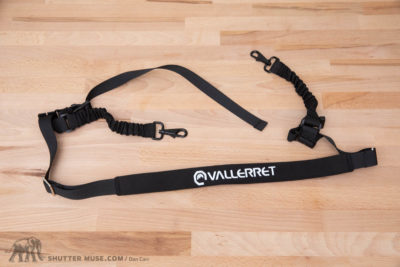
Your second option is to use the handy glove harness that comes with the Alta Arctic Mitt. This harness wraps around your waist and then attaches to your gloves with two bungee cords. It allows you to jettison the entire mitt when needed, safe in knowing that the gloves are securely attached to you and won’t end up in the snow. I’m impressed that the harness comes as standard with the glove.
RucPac Professional Tech Gloves
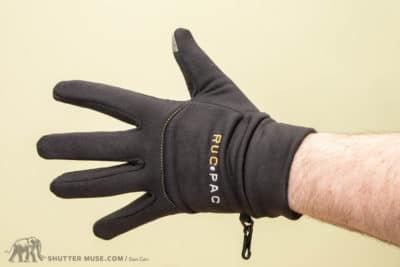
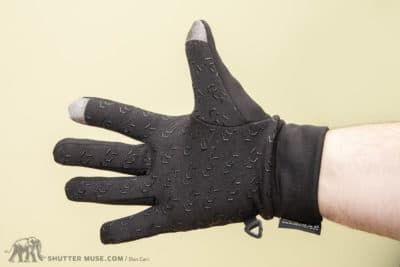
Putting the name of these gloves aside – I dislike it when companies meaninglessly insert the word ‘professional’ into a product name – the RucPac Professional Tech Gloves are an excellent option for those on a tight budget. They are touchscreen compatible, stretchy, comfortable, and provide a confident grip on your gear from a rubberized palm patterning.
The Heat Company Heat 3 Shell (UPDATED)




The Heat 3 Shell from The Heat Company is a highly water-resistant and wind-resistant technical winter mitten that looks just like an expensive technical backcountry ski glove at first glance. Look closer, and you’ll discover a zipper crossing the glove’s palm to reveal your fingers and a leather flap to reveal your thumb. Moving from cozy hands to capturing images takes just seconds.

When I first learned about these gloves, I contacted the US distributor for more information, and I was surprised to get a reply from Canon Explorer of Light, Charles Glatzer. During a quick call with Charles, he explained that the Heat 3 Shell gloves were initially designed so military infantry in the Arctic could use their weapons. He realized they could be great photography gloves, so he worked with The Heat Company to make a few tweaks that would make them even more suitable.
The Heat Layer System
While the soft lining of the Heat 3 Shell glove makes it possible to wear as standalone hand protection, this mitten really comes into its own when worn as part of The Heat Company’s Heat Layer System.

- Layer 1: Optional liner glove. Available in nine different designs with materials for different temperatures.
- Layer 2: Heat 3 Shell. Use as a standalone glove, or in combination with the first and third layer.
- Layer 3: Polar Hood. Additional over-glove protection against wind and moisture in extreme polar climates.
For now, let’s concentrate on the System’s core, the Heat 3 Shell. Later in this guide, we will look at my favorite of the nine different liners from the Heat Layer System, as some of them are excellent photography gloves in their own right. We will also look closer at the 3rd layer in the system, the Polar Hood.
The Heat 3 Shell is stacked with features. Long, elasticated cuffs keep the snow out, and two different drawcords adjust the fit and tightness. Nylon loops on the gloves are provided for hanging and drying at the end of the day. Robust carabiner attachment points can be used to clip the two gloves together, and a zippered hand warmer pocket can be used for instant added heat. Elastic wrist straps prevent you from dropping the gloves in the snow, and goat leather palms and thumb protection deliver durability, abrasion resistance, and waterproofing.
While the wide range of liner options is an excellent addition to the system, there’s no need to use them if you feel temperatures aren’t low enough to cause any issues when your fingers are exposed to operate the camera. When I used the glove without a liner, I was more than comfortable in temperatures ranging from about -5°C (23°F) down to -25°C (-14°F). Combined with one of the liners detailed later in this guide, you can quickly assemble a glove system that will allow you to comfortably operate a camera in temperatures of -40°C (-40°F) and below.
The Heat Company Heat 3 Smart Pro



The removable liners and the broad choice of liners available from The Heat Company make the previously discussed Heat 3 Shell mittens the perfect choice for a photography glove that needs to suit a wide range of winter temperatures. While the separate shell and liner combination adds versatility, some may see it as a negative. Firstly, it can open up almost too many choices. Three shell types and nine different liner options result in 27 possible combinations. Choice paralysis is a real thing that not everyone wants to deal with.
Secondly, having a separate shell and liner gives you twice the number of things you must remember to pack in your camera bag or toss in your car on the way out for a day of shooting. This also gives you twice the number of items to track throughout the day. Sometimes, a more straightforward option is a better choice depending on the person, and for those people, The Heat Company makes the Heat 3 Smart and Heat 3 Smart Pro mittens. These gloves have built-in liners while maintaining all the photography-friendly functionality of the Heat 3 Shell + liner combination.
The Heat 3 Smart is the less warm of the two Smart options and is slightly less warm than a Heat 3 Shell paired with the basic Tactility Liner. It is less warm because the built-in liner is the fingers only. The liner material doesn’t extend down over the hand and around the wrist as it does when wearing a separate liner inside the Heat 3 Shell.
The warmer of the two options is the Heat 3 Smart Pro. This version features a wind and water-repellent Polartec Wind Pro liner and 100% recycled Primaloft insulation, making it more suitable for extremely frigid climates. I have been very happy using the Heat 3 Smart Pro in temperatures down to -30 Celcius (-22°F). The comfort range can be extended by adding the optional Polar Hood and inserting hand warmers into the hand warmer pocket built into the glove.
Vallerret Markof Pro V3




We’ve already got a few Vallerret gloves in the guide, but this should be a surprise when considering their URL is photographygloves.com. This time, we’re looking at the Markhof Pro, a glove that has been a staple in the Vallerret lineup for as long as I can remember. Whenever I test a new glove for potential inclusion in this guide, I have to ask myself whether it brings something new. There are already a lot of great gloves in this guide, and I don’t want to bloat it with a ton of similar products. Regarding the Markhof Pro V3, it was an easy decision for one main reason: value for money.
The current price of this glove is $85. For that moderate price, you get an outer shell of water-resistant goat leather and suede with a non-slip palm, Thinsulate C70 and C100 insulation, and a 100% Merino wool liner to wick moisture, improve comfort, breathability, and odor-resistance. That’s a great deal, and it’s wrapped up in a stylish design with a lovely long elasticated cuff that tucks easily into a winter jacket. For the newer V3 version, Vallerret has used stronger magnets on the flippable finger and thumb, eliminating my only real complaint about the previous version.
How does the Markhof work in winter temperatures? In my testing, I found it slightly warmer than the fleece Vallerret Milford, but it doesn’t come close to bigger mitten-style gloves like The Heat Company’s multi-layered Heat 3 Shell or Heat 3 Smart. With my usual caveats about personal comfort levels and tolerance to cold, I was happy wearing this glove to about -8 Celcius (18F). Stick it inside the Vellerret Arctic Mitt for serious added warmth. The unisex Markhof Pro V3 is now available in two slim-fit sizes for people with smaller hands: XS Slim and S Slim.
The Heat Company Polar Hood

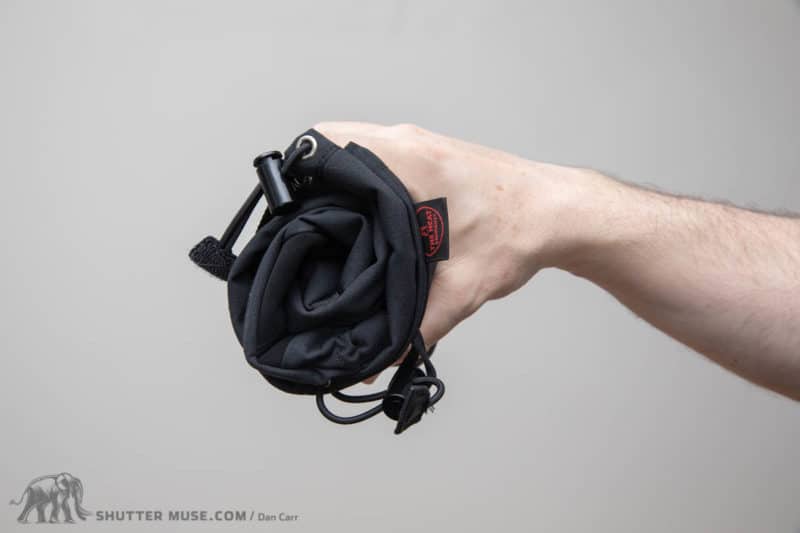
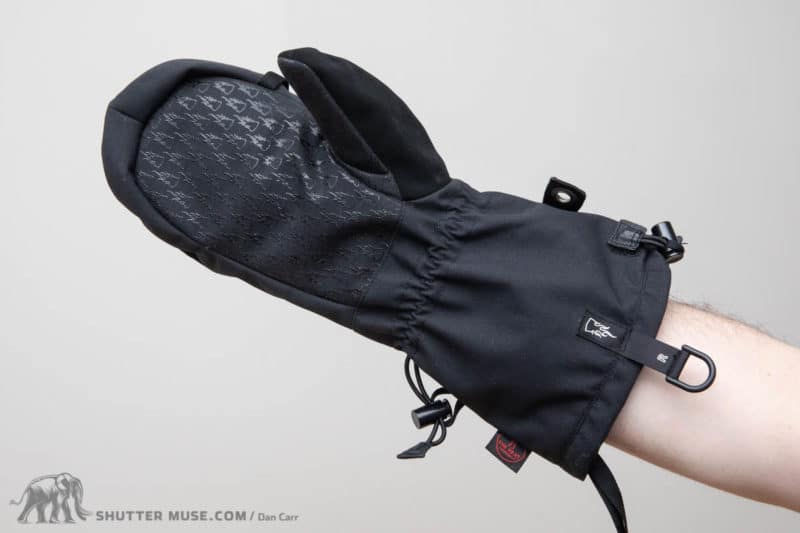
The final layer of defense in The Heat Company’s Heat Layer System is the Polar Hood. This waterproof shell glove is designed to go over the top of your primary photography glove or mitt to protect you from fierce Arctic winds or persistent precipitation from entering zippers or flippable fingers. While those finger accessibility options define photography gloves, giving us much-needed camera dexterity, they are undoubtedly the weak link when used in extreme environments. The lightweight Polar Hood solves that problem.
What I like about the Polar Hood is the universal design that covers almost any other glove. Of course, The Heat Company hopes you use this as an outer layer on their Heat 3 Shell mitts. However, there’s no reason they couldn’t be used to add some extra waterproofing or wind resistance to any of the other gloves in this guide. For polar photography expeditions in the Arctic or Antarctic, either this Polar Hood or the Vallerret Alta Arctic over-mitt is a necessity if you are using gloves with finger access, be it a zipper or simple flip-back fingers.
If your primary glove is already something fairly thick and warm, like the Heat 3 Shell mitt, the Polar Hood makes the perfect companion. Being a shell, the Polar Hood only provides additional warmth by acting as a barrier to cold winds and moisture. On the other hand, the Vallerret Alta Arctic over-mitt is a significant insulated glove in its own right, making it a better option if your inner glove is much thinner.
The Heat Company Durable Liner Pro


The Durable Liner Pro sits toward the warmest end of The Heat Company’s glove liner spectrum. This sheepskin leather-palmed glove features a Polartec Wind Pro backing and replaces the old Durable Liner as the company’s top-tier base layer in their Heat Layer System.
This sheepskin leather Durable Liner Pro glove balances wind protection, tactility, and durability. This glove is designed as a liner for the company’s Heat Layer System–discussed in the section about the Heat 3 Shell glove– but also functions well as a durable general-purpose glove in its own right. Thinner than The Heat Company’s other liners, standalone use is best suited to tasks that require a lot of dexterity with your digits. While wind protection is excellent, moisture protection from thin leather gloves is relatively poor, so you wouldn’t want to choose this liner option if you plan on using it as a standalone glove in cold, wet environments (Pacific Northwest winters, anyone?).
Choose the Durable Liner Pro if you want a smart-looking general-purpose photography glove with ample button-pushing dexterity for milder, dry winter conditions. Or pair this glove with one of The Heat Company’s Heat 3 Shell mittens for one of their range’s warmest possible liner+shell combinations. Heads up: Make sure to buy the newest Pro version of these liners with the blue stitching, not confusing them with any remaining old stock of the non-Pro version with red stitching.
The Heat Company Merino Liner Pro


The Heat Company’s nine options in their liner-style glove category mean more than one option is worth discussing in this guide. This time, we’re looking at the Merino Liner Pro. Again, while these liners are designed as part of the company’s Heat Layer System and pair perfectly with the Heat 3 Shell glove, they can all be used as lightweight photography gloves in their own right, as long as you know their strengths and weaknesses.
The previously discussed leather-palmed Durable Liner Pro is the top pick for camera button tactility, but hot on its heels and offering more breathability is the Merino Liner Pro. Merino wool also has natural anti-odor properties and does a fantastic job at wicking moisture away from your skin, keeping you warmer while you sweat.
You should choose this liner if you plan to break a sweat while on your photographic mission, making it a top choice as a liner for winter sports photographers who are constantly chasing athletes around the mountains. Just know that wind resistance is on the lower side, making it a fantastic liner inside the Heat 3 Shell glove–the warmest liner option in the catalog–but slightly less comfortable as a daily-use lightweight glove in windy environments.
The Heat Company Wind Pro Liner (UPDATED)

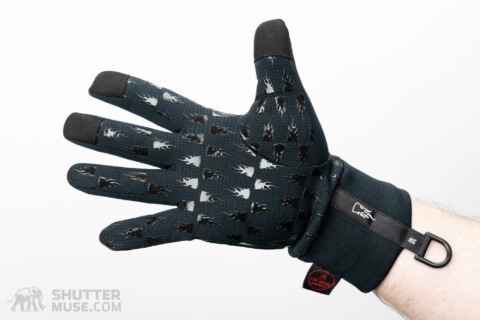
The Wind Pro Liner is one of nine liner options in The Heat Company’s 3-layer Heat Layer System, but simply categorizing it as a glove liner would be a disservice. Like the Durable Liner Pro and Merino Liner Pro on this list, the Wind Pro Liner makes a great lightweight photography glove in its own right. This glove is made from Polartec Wind Pro material with conductive textiles on the thumb, index, and middle fingers for operating touchscreens.
Given the name, this glove unsurprisingly works best in cold, windy environments. It’s not as breathable as the Merino Liner Pro, but it blocks more wind and moisture. It’s a little warmer than the Durable Liner Pro, but the thicker Wind Pro Material that delivers the added warmth creates a lower tactile feel than the thinner, leather-palmed Durable Liner Pro. Some elements of personal preference will be involved in your choice. The Wind Pro Liner does a great job as an everyday glove in milder winter conditions, or you can pair it with the Heat 3 Shell glove. In that configuration, I was easily comfortable in temperatures as cold as -40°C (-40°F) without using hand warmers or adding the third layer of their 3-layer system, the Polar Hood.
If I were purely choosing a liner for my Heat 3 Shell gloves, I would choose the Merino Pro Liner for its breathability and warmth. However, I found the Wind Pro Liner my most used liner option from the whole collection. What it gives up in warmth to the Merino Liner Pro, it more than makes up for in moisture and wind resistance. This makes it a better general-purpose glove and, thus, the pair I usually grab when I head out the door.
The Heat Company Heat Tube
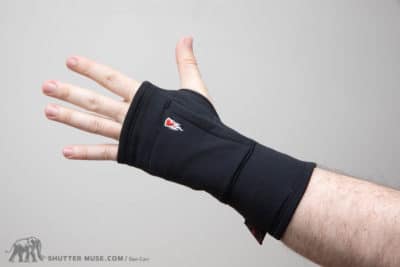

If you’re looking for something to take the edge off a chilly morning without spoiling your dexterity and grip on your camera, the Heat Tube from The Heat Company is your answer. Think of this as one step down from a full glove liner but a good step up from just pulling the arms of your jacket down further to cover your hands. The Heat Tube is available in Vegan Polartec Power Stretch Pro or Merino Power Wool. The Merino wool is a few dollars more expensive but slightly more breathable and odor-resistant. Like all Heat Company liners, the Heat Tube has a pocket for a chemical hand warmer should you need to kick the toastiness factor up a notch.
While there are many options for thick, warm photography gloves, there are fewer options when you need something lightweight to touch the camera directly. Most other glove liners use full finger coverage with touch-sensitive material on the fingertips. This is not always optimal if you are heavily reliant on the touch controls of your camera or trying to manipulate many small custom-function buttons on the front and back of the camera body.
While most people probably came to this guide looking for photography gloves to use in broadly colder climates, warm climates can still have cold mornings. When used alone, these Heat Tubes are an excellent lightweight option on safari in places like Africa. They’re also a great option for people with good circulation when paired with one of The Heat Company’s Heat 3 Shell Mitts as part of their 3-layer system. You should stay away from these if you’re the kind of person who always has noticeably colder fingertips than the rest of your hands.
COOPH Photo Glove Ultimate
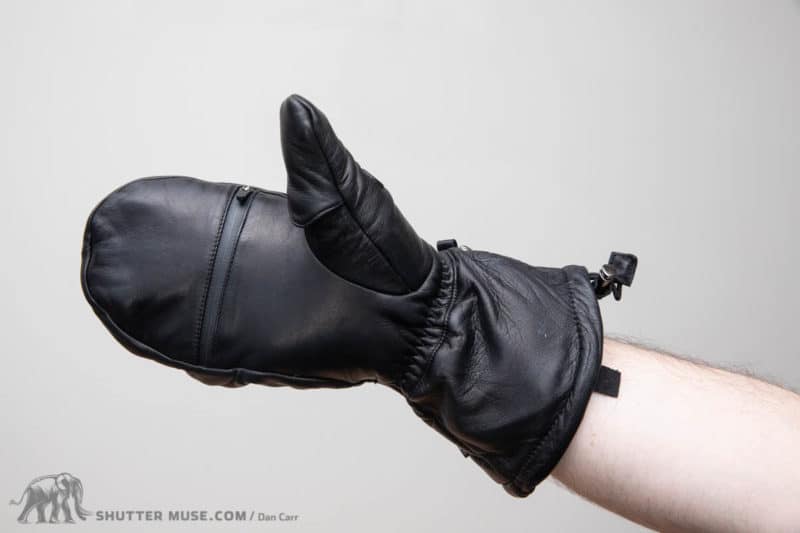
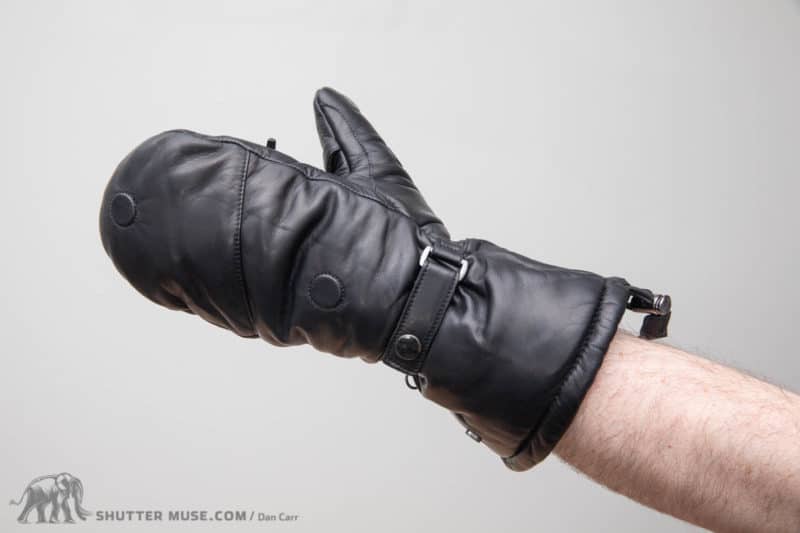
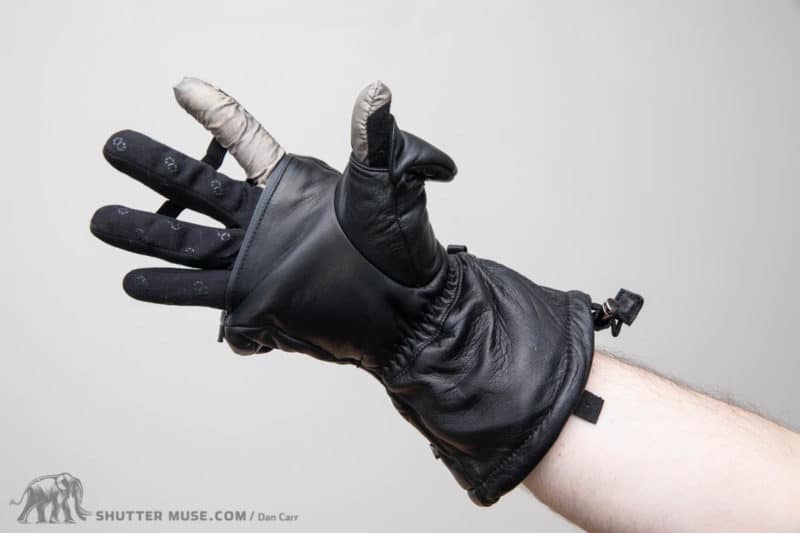
The COOPH Photo Glove Ultimate is a beautifully made goat leather photography glove. At first glance, the Photo Glove Ultimate from COOPH looks similar in design to the design of The Heat Company’s Heat 3 Shell mitt, but there’s one main difference: The liner in the COOPH glove is sewn into the mitt. On the one hand, this removes the ability to use different liners for different temperatures, which some people will find a negative. On the other hand, something must be said for having an all-in-one solution. There’s one less thing to forget (the liners) while packing your bags and one less thing to drop in the snow.
COOPH says this glove will keep you warm in temperatures down to -20 Celcius ( -4F), and though comfort in cold temperatures is subjective, during my testing, I agreed with their recommendation. Purely from a warmth perspective, this is an excellent winter glove. From a comfort and functionality perspective, I wish COOPH had not used such a large section of touch-sensitive material on the index finger. Where most brands opt for a small piece on the tip of the finger, COOPH covers the entire finger. This material is far less comfortable on your skin than the rest of the liner and causes the liner to stick while you try to put the glove on or take it off. From a size perspective, I found overall glove sizing to be on target with their suggestions.
If you like the idea of a liner built into the mitt, you must choose between the full leather COOPH Photo Glove Ultimate, The Heat Company’s leather-palmed Heat 3 Smart, and their warmer Heat 3 Smart Pro. The COOPH glove is the most expensive but the only full-leather photography glove with a built-in liner. If a full leather glove is your main wish, and you’re happy to choose a separate liner, another option is The Heat Company’s Heat 3 Shell Full Leather.

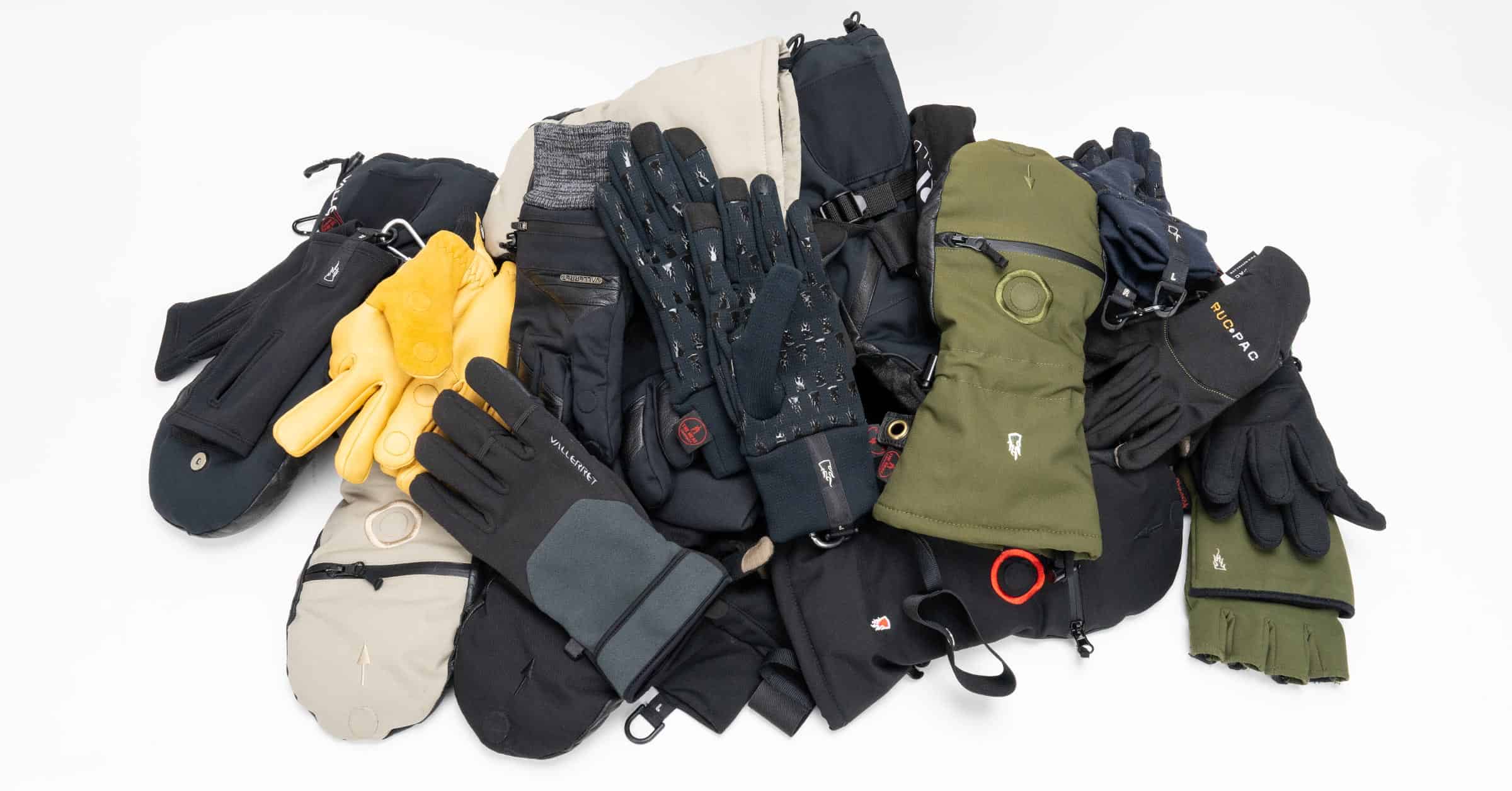
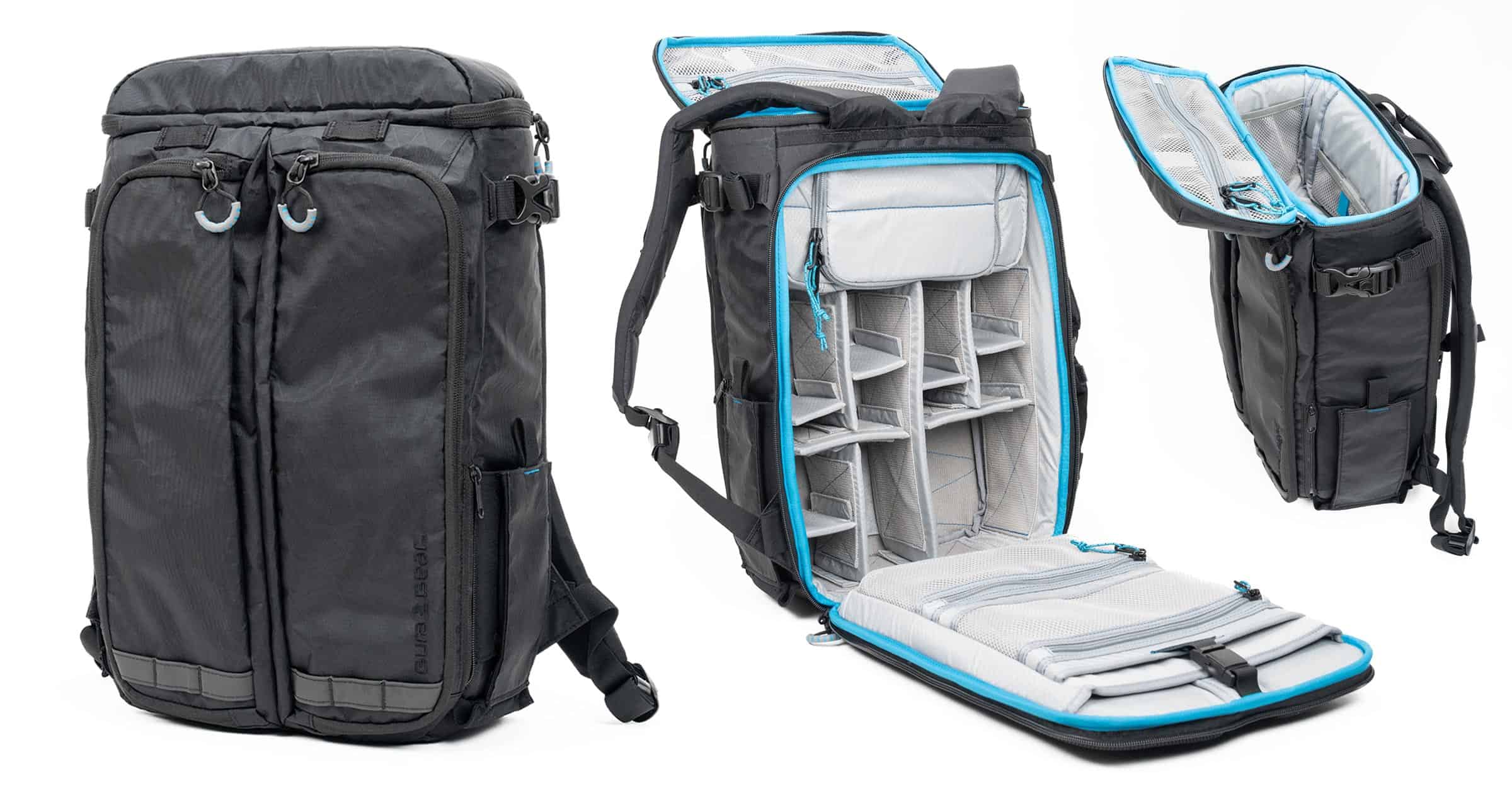
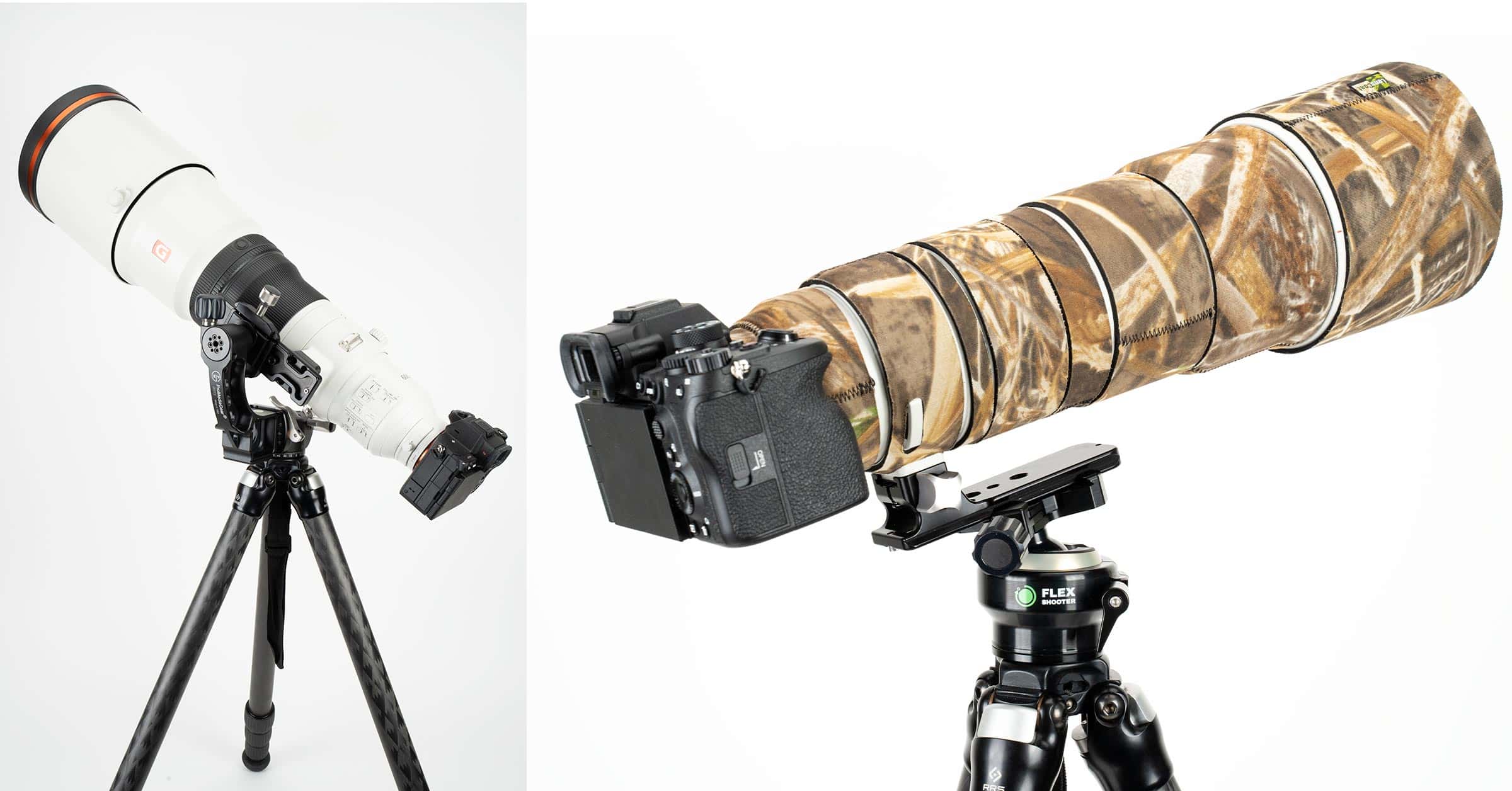
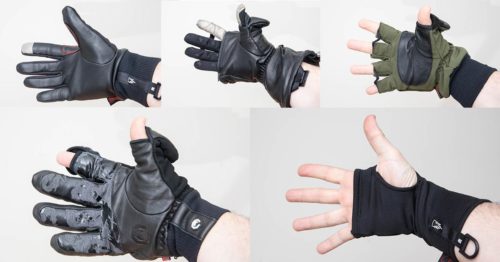
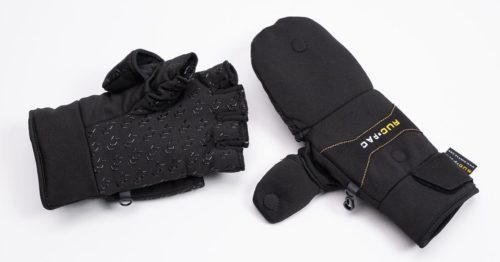
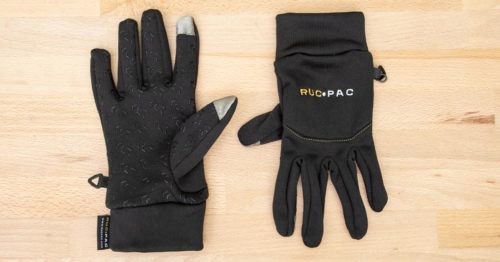
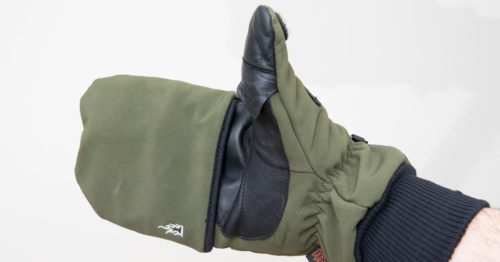
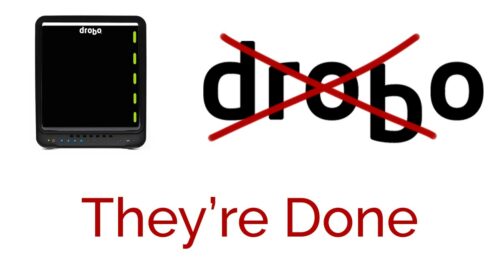
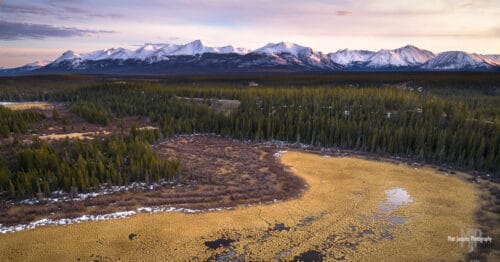
The POW TRANSFILMER only exposes one finger (not two.) Did you really try these?
My mistake, you are correct. I do have a pair though, it was just a typo.
I have Sealskinz shooting gloves. They are so good that I bought a second pair! The thumb and index finger peel back and are held out of the way by small magnets. Comfortable, warm, well made and available in a wide range of sizes.
Thanks for the recommendation, Stuart! I’ll check them out 🙂
I live in Minnesota and when it’s min 5°F , I am not sure I would shoot long time with those gloves!
I have recently seen some gloves with electric heat system included, but I have never try. I would be curious to know if anyone try those to take pictures and if they are not to big.
I’m actually in the process of testing a whole new variety of different gloves, having recently moved to the Yukon where temps often dip below zero F. Come back to this same page later in the winter and I will have updated it with several more option, including a few that would fit your needs I think. I have been testing them for some time now. Dan.
Thanks, good info. I bought the original Smart Mitten back a few years ago when they fist started becoming available before going to the Canadian Rockies on a winter photo trip. The first thing I noticed was the no removable liner that also had no grip whatsoever. The liners were also too thin and pretty useless in my opinion. I was planning to cut out the liner and just use my own, but ended up just keeping them in my pile of stuff I forget I have-so it’s good to see they improved this now.
Yeah this is a huge improvement, Jeff. I absolutely love them, and often wore them without a liner at all. Nice to have that option.
I have very sweaty palms which tend to take the coating off my camera bodies over a period of time (both Nikon D800 & Sony 7r2). I was wondering if you could suggest any gloves which would cover my palms yet leave the fingertips exposed, but without the heating element as I live in the Middle East where the temperatures scale pretty high.
Thx for your write-up … Really comprehensive!!
That’s a unique situation. I think your best bet is to make something like the Heat Tube glove, but make it out of a much lighter material. I don’t know of anything specific.
Hi Dan,
Thanks so much for this write up! I’m traveling from the SF Bay Area to the Yukon in January to (hopefully) shoot the Northern Lights/Wildlife. Unfortunately, I have an allergy to lanolin/wool, so all the merino-based liners are a no go for me, but I’ve noticed that the tactile feeling of some of even the midweight synthetic liners is lacking, so I couldn’t feel the buttons on my camera through the glove! (I was just up in the Sierra doing night shots and had the ability to test out some liners in freezing weather.) Any thoughts on which liners might work in the Yukon winter nights?
Also, I noticed the Alta overmitt allows you to unzip so you can have your fingers free, while the heat shield polar mitt requires that you take off the whole mitt. Is that right?
Alta can be unzipped, yes. The Heat Company Polar is just a waterproof cover for their regular mitt. You can’t unzip the Polar cover, but you can unzip the regular mitt. For most people I think The Heat Company Mitt with the Wind Pro liner is the best option for severe cold. It’s a synthetic liner.
Hi Dan,
You must have much warmer hands than I. I just bought the Heat polartec Wind Pro liners. They definitely block the wind, they fit well, the touchscreen tips work well… but my fingers felt frozen after just 10 minutes walking right at freezing (0 C). I wasn’t even handling a camera, just walking. I can fit them under my warm Hand Out mittens, but I was surprised they didn’t insulate well given all the raves I’ve read.
Yeah, everyone is different!
Hey Dan, loving your website, i think we have same tastes, love RRS stuff especially. So your conclusion resonated with me to the point i had to write a comment. I was in the the Dolomites last winter pre corona and it was so cold, i bought the valleret gloves and guess what i had the same experience as you. Hated them and guess what i was on a workshop and some had the heat company gloves and said the same thing. To Vallarets credit they refunded me as i was unhappy with them. Time to get the heat company gloves 🙂
Feel free to check out my amateur work if you are bored. https://www.instagram.com/stephenvincentgrace/
Thanks for the message Stephen! Glad we’re got you on the right path now for the gloves 🙂 You have some wonderful work on your Instagram account Followed to see more! I would love to go to Petra one day, and had a Japanese trip planned for this fall until the whole world went south 🙁 Maybe next year! Keep up the great work, and thanks for stopping by my site.
It’s hard to say
Would you use the HEAT SHELL for skiing with out the HOOD? Thanks.
Thanks so much for this review Dan, For Northern Minnesota with my primary hobby being North Shore of Lake Superior photography walks (some times a snow shoe walk or cross country skiing) it sounds like best option is Heat Company Heat 3 Shell and the Wind Pro Liner. Is that correct?
Yes, that is a versatile combination. This is what I use myself.
Hi Dan,
Thanks for the timely review, certainly the best I have seen. I’m off to northern Minnesota to photograph birds (not just owls!). My fingers are sensitive to the cold and I have tried numerous combinations of mitten/liner (even the dual hand warmer used by quarterbacks!) and yet to find one that really works for me. Once they get cold I am pretty much done for the day.
Most of my time I am waiting for the birds to show-up or for there to be action. As we know things can happen very quickly so I like to have my thumb & index fingers flexible enough to focus (back button) and fire shutter/change aperture etc. I like the idea of a liner and shell as long as I get my finger/thumbs out quickly and still keep them reasonably warm. I was thinking of the Heat Co Heat 3 Shell with the company’s Polartec Wind Pro Liner. Maybe that is an overkill? Is there a liner to go with the Heat 2 Soft-shell? Would the Polartec Wind Pro Liner too much?
You can’t use liners with the Heat 2. The finger holes are not big enough. I don’t think your plan sounds like over kill.
Seems like some of the links are now broken and sadly a lot of these are sold out and back ordered. It will be spring before I can get some LOL.
Thanks for the advice though.To bad I cannot use it right now.
I’ll have a look through and see if I can find the broken links… unless you can point them out to me?
Sadly, there is nothing I can do about back-ordered ones. It’s a popular time of year to buy this kind of product.
This guide is really well done and very helpful. I really appreciate you taking the time and sharing your knowledge.
Thank you, Beto! I really appreciate that.
Hello again, Dan:
Awesome write-up, man. Thank you so much for putting all the work into knowing what to recommend, and why.
We just ordered some Heat 3 and Heat 2 mittens, and the Heat Polartec liners from B&H, using your affiliate link. As usual, you certainly earned your keep, sir!
Cheers,
Carl + Angela
P.S. Angela is from B.C., and appreciates that you are a fellow Canadian! ccn
Hi Dan,
Just discovered your blog and love your way of looking at gear! Reviewers that thoroughly try out stuff in real world seem to be very sparse. Many concentrate on specs and features while completely missing the advantages or shortcomings in real usage. So thank you for the great reviews!
can you help me deciding between the Heat 2 Softsheel and the RucPac Extreme gloves? From your review, they seem so similar regarding performance. Price is also quite close. Anything that might make a differnce?
Unfortunately, I can’t compare them side by side, as the heat 2 are sold out at the moment in germany, while the RucPac ship from UK and shipping just for trying out seems unresponsible to me. So I want to buy the RucPac now or wait for the Heat 2.
Best, Alex
Alex, thanks so much for your comments. I’m glad that people are seeing the difference in what I do, compared to some other blogs that never even handle the products, let alone actually use them in the field.
Regarding your question, this is very tough. Honestly, I have both these pairs of gloves on my shelf and have been going back and forth between them for two months now trying to decide if there is a “right choice”. You can’t go wrong with either, but the main difference is that I feel the RucPac gloves better suit a cold, dry climate. Where the Heat 2 gloves deal better with a cold, wet climate. Both are great options. Make your choice based on whether you would say your climate is dry or wet.
I am a bird photographer who goes on winter photo trips regularly. I am keen to get some electrically heated glove liners from Power in Motion (Canadian), which have been highly recommended. The issue is, what to wear over them? Ideally, gloves that themselves allow enough dexterity to operate a camera would be best. But if this is not possible, would the Heat 3 shell be a good match? It appears I could keep the shell closed until it’s time to take photos and then I could retract it to operate the camera. Is there a flaw in my strategy here? Is there a better alternative?
Impossible to say for sure, as I have not used those gloves. I suspect the Power in Motion gloves would be too thick to wear under the Shell. Personally, I can’t think why you would want to complicate things by having electric gloves. The proper Heat 3 System will keep you warm enough if you choose the warmest liners such as Polartec Pro or the Merino ones.
Thanks Dan for writing such a comprehensive cold weather photography glove list.
Interesting to read as I’ve finally decided to venture off to Iceland next March. The Heat 3’s with a pair of Merino Liner Pro’s (Sorry abou the ‘Pro’ part!) look like they’ll be making their way to me shortly.
I’ll have to see what cold weather shots you’ve been taking on Instagram.
Cheers
Wes
Thanks, Wes! Yes, check out my Instagram. More than half my year is cold up here, so there are usually some frosty shots.
Hi Dan,
Amazing article. Really helpful.
We are doing an Antarctic peninsula cruise this winter (summer there of course). The temps are supposed to fluctuate around 0C (32F). However, we are hearing that the wind can be really crazy and the Zodiac ride to the shore can be cold and possibly wet from ocean splash, etc. and you are just sitting there for 10-20 minutes. Once on land there will be some walking/hiking.
As someone who does not live in a cold climate I am kind of at a loss for what to plan for. It sounds like wind chill could make it feel much colder and add a wetness factor.
I am looking for photography gloves because that’s my amateur hobby. Also trying to find decent gloves for my wife and 9 year old daughter to not end up frozen and uncomfortable
Any suggestions or insight you have would be so appreciated.
Thanks again!
Sounds like the Heat Company 3-layer system is perfect for you. Just put the Polar Hood on when n the zodiac and if you get wet, you can remove those while you are on land. For your family, I would simply recommend some leather palm and Gore-Tex backed ski gloves. DaKine or The North Face.
Thanks for the comprehensive review Dan.
I must say I’m surprised at at your experience with the Heat 2 Softshell, I purchased a pair of these and the first time out at around 0C I had very cold fingers; the finger covering is very thin and basically without insulation. Obviously it’s a personal thing but I’m not particularly susceptible to cold hands and these bulky and expensive gloves provide little advantage over cheap fingerless gloves for me.
Like I said somewhere in the guide, it’s possible that living in a cold climate has changed my tolerance. Or perhaps I have very good circulation. It’s not unusual for me to wear no gloves at all when the temperature is hovering around zero Celsius. If they didn’t suite you, I hope you were able to return them and try something else on the list.
overall is a nice article, but a pitty not seeing the ones I wanted to check here, the Heat Merino liner Pro and Vallerret Power Stretch Pro Liner or also the Vallerret Markhof Pro V3
I have just received the Markhof V3 for testing. I don’t yet know if it will make it onto the “best” list, but stay tuned. I’m also hoping to add the Heat Merino liner but they are out of stock in my size at the moment. The Valleret Powerstretch liner will not be added to this list.
I appreciate the detail that you went into with all of these gloves! I’m specifically looking at purchasing the Heat 3 Layer System, and was wondering what you might have to say about the sizing of both the liners and shell. Considering the thickness of certain liners, would sizing the shell up be advisable? Or would any liner fit comfortably within the same sized shell?
Hi Dan,
I live in Florida, and we are going to Antarctica in late November 2022 (Early spring) with Hurtigruten. I will be bringing both Sony AR7 II cameras and lenses. There will be times that we will land and venture on the ice for exploring. I believe we will be in Antarctica proper for 5-6 days and the rest sailing with a stop at the Falkland Islands. What would be your best recommendation, considering price and that they probably will only be used once?
Thanks Jim
No help on the recommendation but when I went to Antarctica 3 years ago. The one thing I didn’t get right was having a waterproof glove or top layer while on the zodiac. We’d have to grip the soaked side ropes on the zodiac and my hands got wet and cold pretty quick.
Thanks for your insight, Margaret!
Great article although I’m rather overwhelmed with Info being from Southern California and never really needed them except for fashion and Antarctica trip 3 years ago which I got the gloves part wrong. (Hands always wet holding the wet zodiac ropes.)
I’m definitely in need of good gloves for an Arctic expedition coming up. I use 2 cameras so dexterity is tops and warmth. Longyearbyen high and low is 32/31 degrees F. (Closest I could find)
I had bought the PGYTech (before your article came out) but they are a bit big unless I purchase thicker liner like the The Heat Company Polartec Heat Tube.
Between work, getting Covid- I’m rapidly running out of time.
Thank you for your recommendation.
Hi Dan, do you happen to know if there are some fingerless alternatives for the Heat & Merino Tube? I live just a couple of latitudes south of you and was planning to get either of them + The Heat 3 Shell for -30 and below icefishing/photography, but they are both out of stock for my hand size. Alternatively, maybe I can make do by adding a pair of thinner gloves with thumb+index flip (e.g. the FreeHand) if you think the inside of the Heat 3 Shell is big enough to fit them.
P/S: I already have full-finger “tactile” gloves, and they do not work with my Nikon Z bodies’ touchscreen that well – hence the idea of getting something that can let me expose my index+thumb quickly.
Unfortunately, The Heat Company doesn’t make fingerless gloves beside the Tube. I wish they did. If you find any good ones, let me know!
I bought the Heat 2 Softshell mitts on the strength of their recommendation in this roundup, a few years back. While I agree that they probably offer good versatility in some climates, they haven’t panned out for me in the brutal Upper Midwest (MN, USA) winters. The shell part is clever, but the included liners were sized weirdly for me, and the very good wind-blocking properties ultimately can’t help with constant, seeping cold.
What has worked best for me is the two-glove Trek System from a company called Beyond Clothing. The inner pair – termed “work gloves” – are essentially super-durable liners featuring cow and goat leathers on the palms and knuckle guards, as well as a tech fabric. They aren’t waterproof, but they block wind fairly well, and can resist some moisture if reinforced with a beeswax rub on the leather bits. They are very nimble and allow complete control over my camera. They also look totally badass. The outer gloves are like a puffy jacket, providing additional weatherproofing and rapid warmth regeneration. They have little rubber nubs on the gripping surfaces, and cloth pull loops to help slide them back on. Both sets of gloves have touchscreen capability, and the outer glove is flexible/compressible enough to allow basic operations like backbutton focus and shutter without removing it.
The obvious downside of this system is that you frequently have to fully remove the outer gloves, but honestly I haven’t found that to be more onerous than fiddling with various fold-back thumbs, etc. The only real problem is that they have to be stowed somewhere for a moment, as they lack the retaining straps of some of the options in this list.
The inner gloves stay in my photo pack year-round and work solo into the low 40s (F). With the outer gloves and reasonable activity levels, I can shoot indefinitely in teens or single-digits with bad wind. Maybe not the best choice for an always-on sports photographer, but they fit my workflow well (hiking around to find and compose a shot, burst of setup/shooting, back to movement).
Thanks for adding your experiences, Patrick!
The Heat 2 SoftShell is not the best for severe cold. The WindPro liner with the Full leather shell is the warmest combo. Moreover, if you do not need your thumb for dexterity the Full leather Pro shell offers a closed thumb for even more warmth and extra long, fold-out gauntlet for even more warmth.
I also use a three layer system here in the Rockies of Colorado, Wyoming, and Montana but made up of different Valleret gloves. Base layer being their Polartec Power Stretch Pro Liners for mild cold without a lot of wind, the Valleret Tinden added for down to – 27 Fahrenheit, after that I add the newer Alta Arctic Mitt version with the harness that I received on December 27th, 2022 when they were released. I love the quality of the Vallerets, the magnets that keep the fingertips out of my way while I adjust my settings, and the little zippered pouches that allow me to add Little Hotties disposable handwarmer packets to the gloves for night sky shoots (Geminids/Aurora/etc.) when you don’t move around much. Look forward to giving them a real test across the border from you in Fairbanks, AK for Aurora shoots later this year
I wonder if the magnets in some of these gloves are strong enough to affect a wrist watch or an SD camera card if they come into contact?
Definitely not. I have the heat company gloves, they are weak magnets, but plenty strong to hold the gloves open.
I have the, “The Heat Company SHELL” mitten, size 9. It has leather on the palm only.
With this mitten, I use liners from local stores as I hated the Heat Company liners. I’ve had two types and they were both thin, fragile, and expensive. I’ve had them rip on me when putting them on after a few uses. Wouldnt recommend.
Anyway, The H.C. Shell is a great glove, but I do not find it warm. With a good liner, I’m able to comfortably stay warm at about 0 to -10C at the lowest. Anything lower and I start to get cold fingers. In Alberta, Canada, I want to be comfortable down to -50C. If you go to any store and buy good mitts, they will be much thicker, but missing the important features…
I’m on the fence on selling my The H.C. Shell mittens and considering one of three options:
1) Getting the Vallerret Model instead, but if it’s warmer, is it??
2) If Vallerret isn’t warmer, I’d stick with The H.C. mitten, but get a larger shell so I can fit a thicker liner/glove underneath, such as the Vallerret Tinden. And also maybe swap for the full leather one instead “Shell Full Leather”.
3) Stick with what I have, but buy a BIG mitten to go overtop my current setup. Similar to what The H.C. has with their Polar Hood, but one that is nicely insulated as theirs isn’t. – Mammut Arctic Mit, or Rab Endurance. Annoying to have this extra layer, but you’d be toasty
Thoughts?
Awaiting Dan’s 2 cents, here is some from me considering we are in the same province and just went through the cold snap. I want to preface that I definitely have warmer hands since I could wear the shell by itself in -15 to -20 just fine icefishing before I had to bring out my gloves. And I have yet to make use of the hand heater compartment.
1/ The Valleret Arctic Mitt is warmer but not designed to be worn as a standalone.
2/ This was sort of my approach when I bought mine: my hand was right at the end limit of size 9, so I bought a size 10-11 one instead and it fits my second layer of gloves extremely well.
3/ Probably the most fool-proof approach especially for -50 condition. If you have a way to quickly take off and secure the mittens on a clip this might be the way to go.
Aw, this was a very good post. Taking the time and actual effort to produce a very good article… but what can I say… I hesitate a whole lot and never seem to get nearly anything done.|
Dear Sir / Madam
We are professional manufacturer for all types of custom Sports gloves we are offer you kindly inform us your interested items We are show you our best quality and prices as per your interested items our quality high in the international market – our prices are most lowest in the market – our turnaround are much fast by courier service
We are offering free mock up design – quality guarantee – guaranteed delivery – lowest prices – high quality.
my father is one gloves pattern master he making all gloves with 40 years experienced.
Nice article, which you’re starting with saying that things took a turn when you became professional photographer…
So, how could you tell that moment? Did get full time employment or found some steady way of selling you pictures? If it’s the later, which? How?
Thanks!